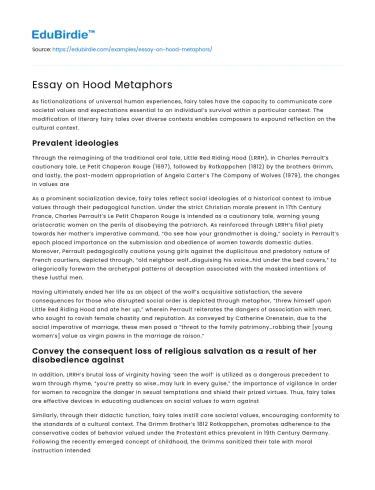As fictionalizations of universal human experiences, fairy tales have the capacity to communicate core societal values and expectations essential to an individual’s survival within a particular context. The modification of literary fairy tales over diverse contexts enables composers to expound reflection on the cultural context.
Prevalent ideologies
Through the reimagining of the traditional oral tale, Little Red Riding Hood (LRRH), in Charles Perrault’s cautionary tale, Le Petit Chaperon Rouge (1697), followed by Rotkappchen (1812) by the brothers Grimm, and lastly, the post-modern appropriation of Angela Carter’s The Company of Wolves (1979), the changes in values are
Save your time!
We can take care of your essay
- Proper editing and formatting
- Free revision, title page, and bibliography
- Flexible prices and money-back guarantee
As a prominent socialization device, fairy tales reflect social ideologies of a historical context to imbue values through their pedagogical function. Under the strict Christian morale present in 17th Century France, Charles Perrault’s Le Petit Chaperon Rouge is intended as a cautionary tale, warning young aristocratic women on the perils of disobeying the patriarch. As reinforced through LRRH’s filial piety towards her mother’s imperative command, “Go see how your grandmother is doing,” society in Perrault’s epoch placed importance on the submission and obedience of women towards domestic duties. Moreover, Perrault pedagogically cautions young girls against the duplicitous and predatory nature of French courtiers, depicted through, “old neighbor wolf…disguising his voice…hid under the bed covers,” to allegorically forewarn the archetypal patterns of deception associated with the masked intentions of these lustful men.
Having ultimately ended her life as an object of the wolf’s acquisitive satisfaction, the severe consequences for those who disrupted social order is depicted through metaphor, “threw himself upon Little Red Riding Hood and ate her up,” wherein Perrault reiterates the dangers of association with men, who sought to ravish female chastity and reputation. As conveyed by Catherine Orenstein, due to the social imperative of marriage, these men posed a “threat to the family patrimony…robbing their [young women’s] value as virgin pawns in the marriage de raison.”
Convey the consequent loss of religious salvation as a result of her disobedience against
In addition, LRRH’s brutal loss of virginity having ‘seen the wolf’ is utilized as a dangerous precedent to warn through rhyme, “you’re pretty so wise…may lurk in every guise,” the importance of vigilance in order for women to recognize the danger in sexual temptations and shield their prized virtues. Thus, fairy tales are effective devices in educating audiences on social values to warn against
Similarly, through their didactic function, fairy tales instill core societal values, encouraging conformity to the standards of a cultural context. The Grimm Brother’s 1812 Rotkappchen, promotes adherence to the conservative codes of behavior valued under the Protestant ethics prevalent in 19th Century Germany. Following the recently emerged concept of childhood, the Grimms sanitized their tale with moral instruction intended toward children due to “the principle of discipline and punishment in the 19th century, where a watchful eye is constantly on the alert for social deviates,” as conveyed by Jack Zipes. Perrault utilized a belittling metaphor in the characterization of their protagonist as a “sweet little girl, everybody loved her,” to perpetuate the archetypal patterns of inferiority and vulnerability of children considered virtuous, under the highly patriarchal values of male dominance prevalent in society. As an agent of socialization, Rotkappchen focuses on communicating the importance of discipline and obedience as instilled through the herald’s obligatory instruction, “be a good girl…walk carefully and do not stray from the path, or you might fall and break the bottle,” implying the inevitable risks of straying from the path, a symbol of compliance to societal expectations. The pedagogy and guided maturation of children in compliance with societal expectations are crucial in ensuring their social survival and approval. During LRRH’s sensual indulgence in the forest, the brothers Grimm utilized internal dialogue, “bring Grandmother a bouquet of fresh flowers…make her happy,” to demonstrate her sense of filial responsibility despite having already been tempted across the domestic threshold and reinforces the notions of obedience embedded in the cultural psychology. Subsequently, the employment of the moral anticlimax, “[a hunter] began to cut open the belly of the sleeping wolf…never leave the path again…no-one harmed her,” symbolically representing patriarchal protection, in the guise of the hunter, required to allow redemption and religious salvation. Hence, the didacticism of fairy tales
The adaptive nature of fairy tales enables the composer to challenge existing social ideologies to reflect the values of contemporary contexts. In contrast to previous appropriations, Angela Carter’s 1979 post-modern subversion The Company of Wolves challenges the patriarchal structure of society through the redefining of conventional gender expectations in support of second-wave feminism. By blurring the pre-existing patriarchal views of brutality archetypal to men, Carter utilizes emotive language in “wavering howl…fearful resonance, some inherent sadness,” to challenge stereotypes of human nature and humanize the wolves by revealing the inherent duality and emotion present in all characters. Moreover, written during a period of the widespread sexual revolution, Carter metaphorically implies the power of LRRH’s virginity in, “stands and moves within the invisible pentacle of her own virginity,” to highlight the independence and sexual power gained by women through the feminist movement. Upon LRRH’s arrival at the grandmother’s house, biblical denial is employed as a form of postmodern discourse in “for the first time she’d seen it so, the Bible lay closed on the table;” to symbolically represent the diminishing influence of religion over sexuality, by undermining the significance of existing religious mores and alluding to the newly-secular society wherein women were no longer held under the confines of traditional Christian values of chastity. Subsequently, Carter employed authorial intrusion in, “the girl burst out laughing; she knew she was nobody’s meat,” to connote LRRH’s sexual emancipation.
Additionally, this is reflective of the introduction of contraceptive pills in the second wave of feminism which granted women the freedom of choice and prevented their sexual objectification.






 Stuck on your essay?
Stuck on your essay?

